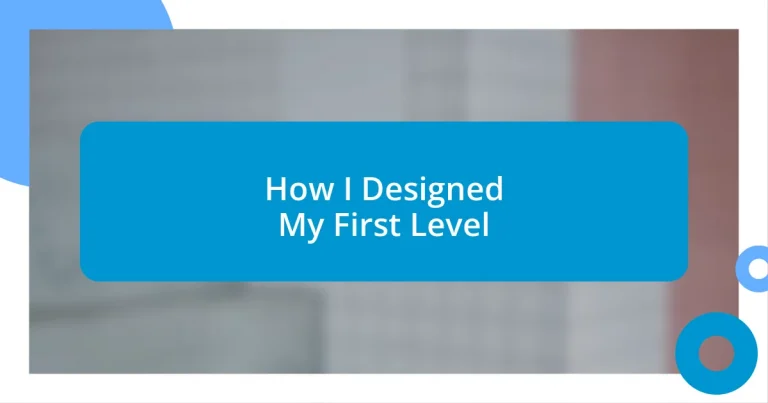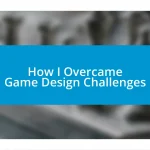Key takeaways:
- Game level design merges storytelling and emotional engagement, shaping player experiences through thoughtful arrangement of elements.
- Iterative playtesting and embracing feedback is crucial for refining level design, ensuring a smoother and more enjoyable player experience.
- Choosing the right tools enhances creativity and efficiency, while attention to detail in design can significantly transform the player’s emotional journey.
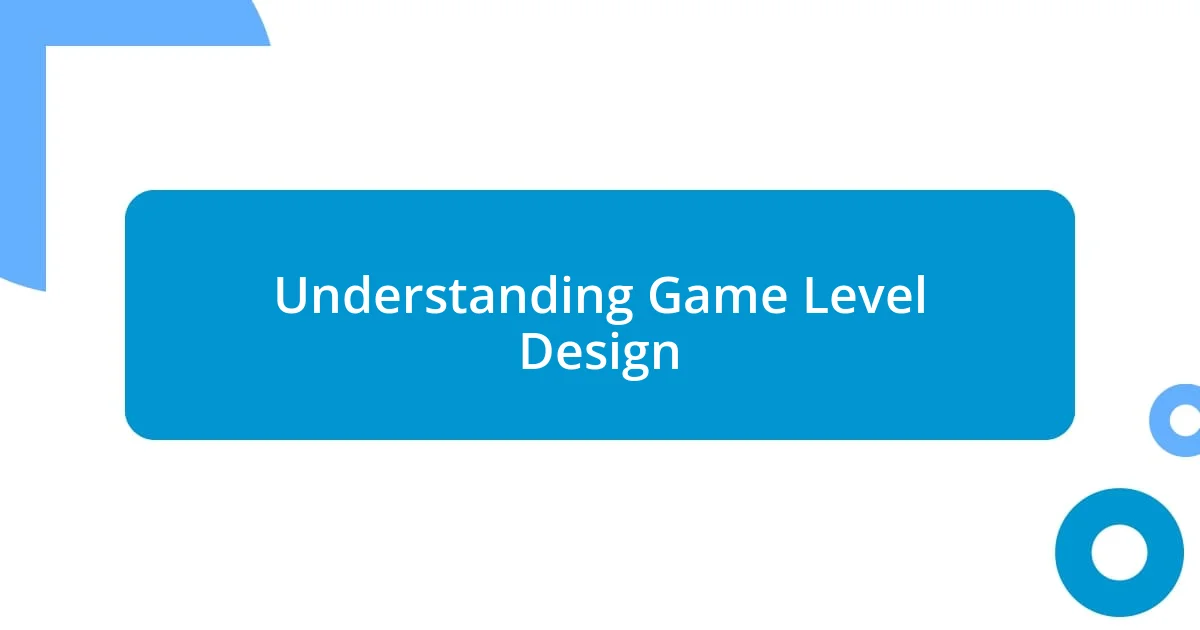
Understanding Game Level Design
Game level design is a fascinating blend of creativity and technical skill. I still remember my first experience when I realized that a level isn’t just a series of obstacles. It’s like telling a story; each element must guide the player emotionally and help them connect with the gameplay.
When I started crafting my first level, I had to consider the player’s journey within the space. How do you want them to feel? I remember feeling exhilarated and overwhelmed seeing my design come to life, where every corner held a surprise! This realization that I could manipulate the player’s emotions by arranging elements in a thoughtful way was both daunting and exciting.
Every good game level balances challenge and reward. Think back to a game you’ve played; didn’t you relish that moment when you overcame a tough obstacle? In my experience, crafting levels requires empathy—understanding what the player may feel at each stage and adjusting the difficulty accordingly. Balancing frustration and satisfaction became one of my biggest lessons in ensuring a memorable gaming experience.
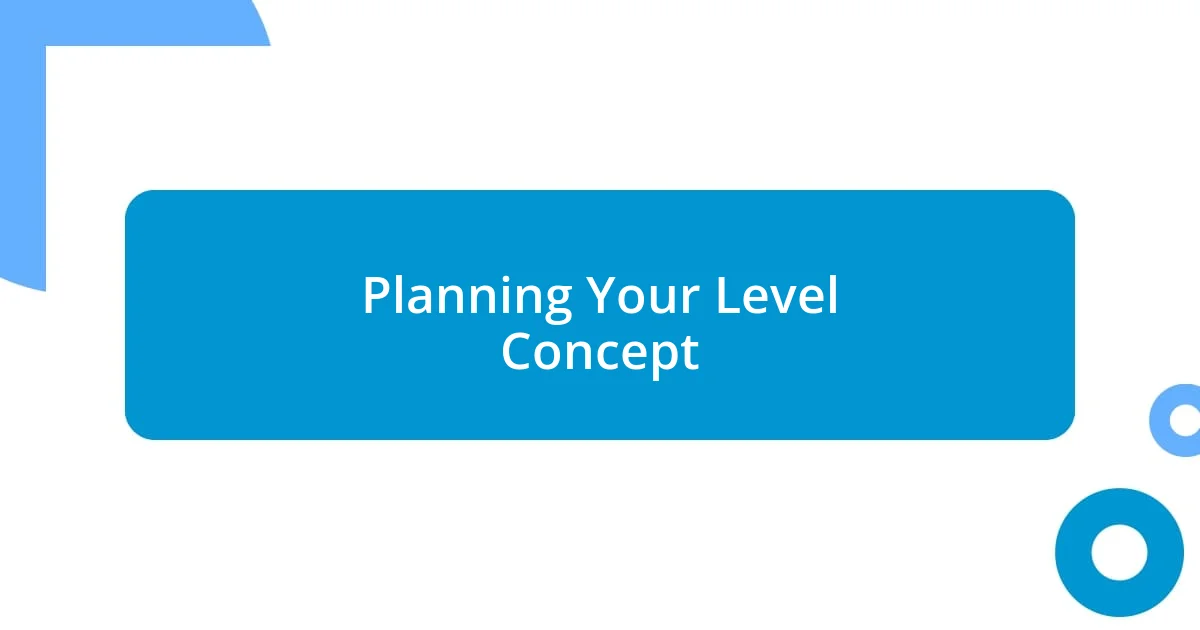
Planning Your Level Concept
When planning my level concept, I focused on visualizing the player’s experience right from the start. I distinctly remember sketching my initial ideas on paper, where I tried to imagine every jump, every enemy encounter, and how players would react. It was a blend of intuition and experience; I wanted them to feel a rush of excitement without pushing them into frustration.
I often created a mind map to organize various elements like themes, challenges, and rewards. It helped me see how different components connected and flow together. One of my key insights was realizing that the first few moments can make or break the player’s engagement. This is where I focused on crafting an intriguing introduction that welcomed players and invited them into the world I was building.
Another technique that worked for me was developing a narrative behind the level. I remember deciding to incorporate a backstory that would unfold as players progressed. This not only made the experience richer but also created emotional stakes for the player. By weaving an engaging narrative into gameplay, I found that it transformed mere mechanics into a compelling adventure.
| Concept Element | Example from My Experience |
|---|---|
| Initial Sketches | Visualizing player jumps and enemy encounters on paper |
| Mind Mapping | Organizing themes, challenges, and rewards for clarity |
| Narrative Inclusion | Creating a backstory that enhances player engagement |
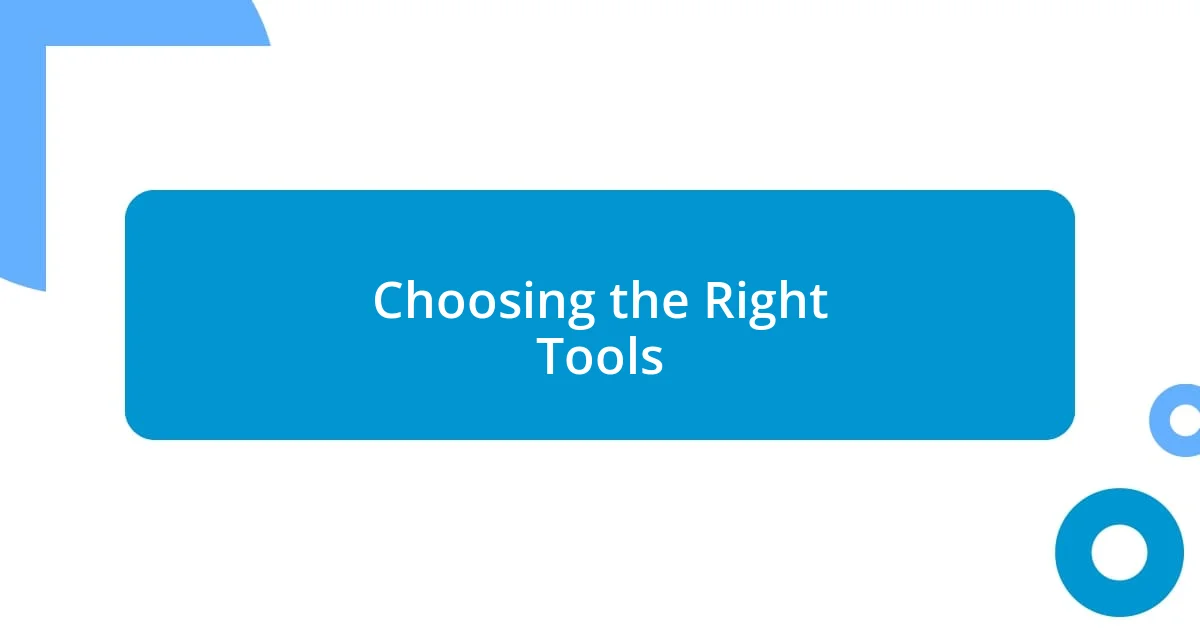
Choosing the Right Tools
Choosing the right tools can significantly impact the design process. I remember feeling a bit lost when I first started, unsure whether I should dive into expensive software or stick with free options. I ultimately decided to try a mix of both, which turned out to be a game-changer for my workflow. Having the right tools not only streamlined my design process but also allowed me to express my creativity more freely.
Here’s a concise list of recommended tools that I found valuable during my journey:
- Game Engines (e.g., Unity or Unreal Engine): They offer powerful features and community support, allowing you to focus on design rather than technical details.
- Art Software (like Photoshop or GIMP): Visual assets are crucial. These tools help in creating engaging graphics or textures that enhance the gaming experience.
- Level Design Tools (such as Tiled or ProBuilder): They simplify the process of laying out levels, which is essential for prototyping.
- Collaboration Platforms (like Trello or Slack): Keeping track of ideas and feedback helps maintain perspective and organization during the development process.
Each tool has its unique strengths—choosing the right combination ultimately made my level design experience more enjoyable and efficient.
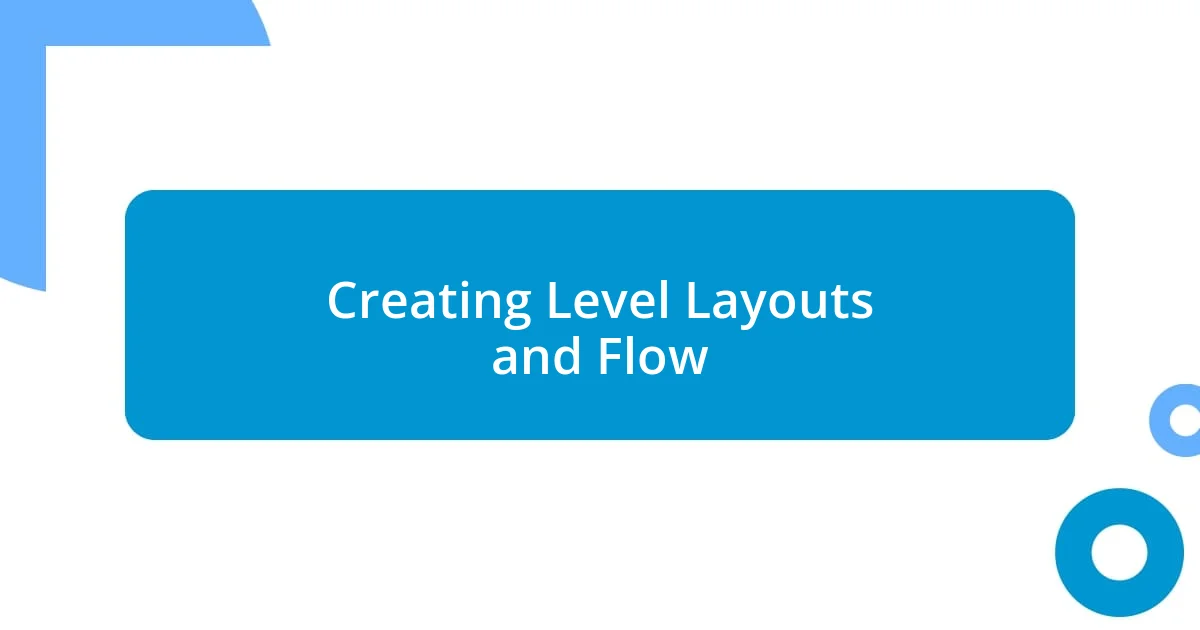
Creating Level Layouts and Flow
Creating level layouts is like crafting a puzzle that players get to solve. I remember my first attempt, where I sketched out pathways that felt intuitive but were also filled with surprises. Would players feel accomplished climbing a steep hill, only to find an unexpected enemy waiting on the other side? It was thrilling to think about how my design would stir emotions during their journey.
As I fleshed out the flow of the level, I learned the importance of pacing. There’s a delicate balance to strike—too much action can overwhelm players, while too little can make them disengaged. I vividly recall one moment when I decided to add a quiet, scenic spot for players to catch their breath before the next intense encounter. It wasn’t just about gameplay; it was about crafting a narrative rhythm that resonated with their feelings.
Connecting different sections smoothly became another focus for me. I experimented with visual cues that would naturally guide players along their path. I often questioned how I could make transitions feel seamless. Adding subtle landmarks or unique environmental features helped, creating a sense of exploration and discovery. It made each corner feel inviting rather than intimidating, enhancing the overall experience I aimed to deliver.
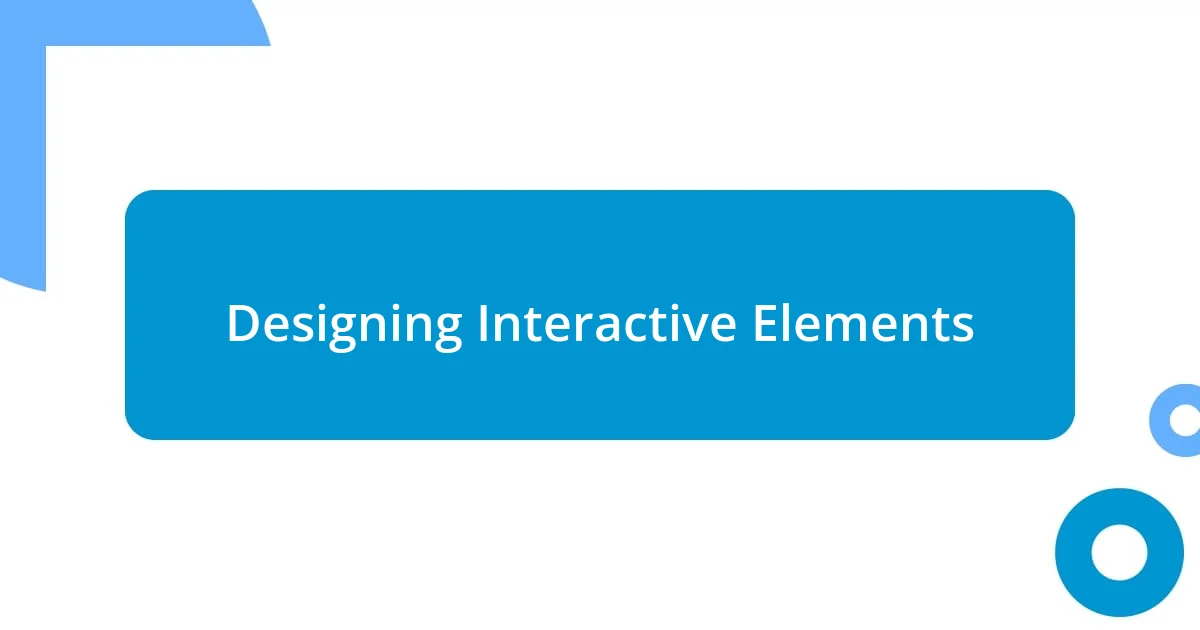
Designing Interactive Elements
Designing interactive elements was one of the most exciting parts of my level design journey. I recall the moment I decided to incorporate dynamic objects, like levers and traps, that could trigger different responses from players. Watching a player unknowingly trigger a hidden trap was not just a test of my design skill; it was fascinating to see them react in real-time, their joy or frustration framing their experience. How cool is it when your design elicits such immediate emotional responses?
Interactivity also meant I had to think carefully about player choices. I remember designing a puzzle that required players to choose between two paths, each leading to unique rewards. The thrill of decision-making added depth to the gameplay. Wasn’t it exhilarating to create moments where players had to weigh their options, knowing that their choices impacted their journey? Crafting these interactive elements felt like giving players the power to shape their experience, making it all the more immersive.
I found that feedback mechanisms, like changing scenery or audio cues, enhanced player engagement significantly. For instance, when a player successfully solved a riddle, I added a sound cue that highlighted their achievement. This small touch not only celebrated their success but also made the world feel responsive and alive. Have you ever considered how much a simple sound can amplify a moment of victory? It was gratifying to see how these interactive elements transformed the player’s emotional journey, making each step feel meaningful.
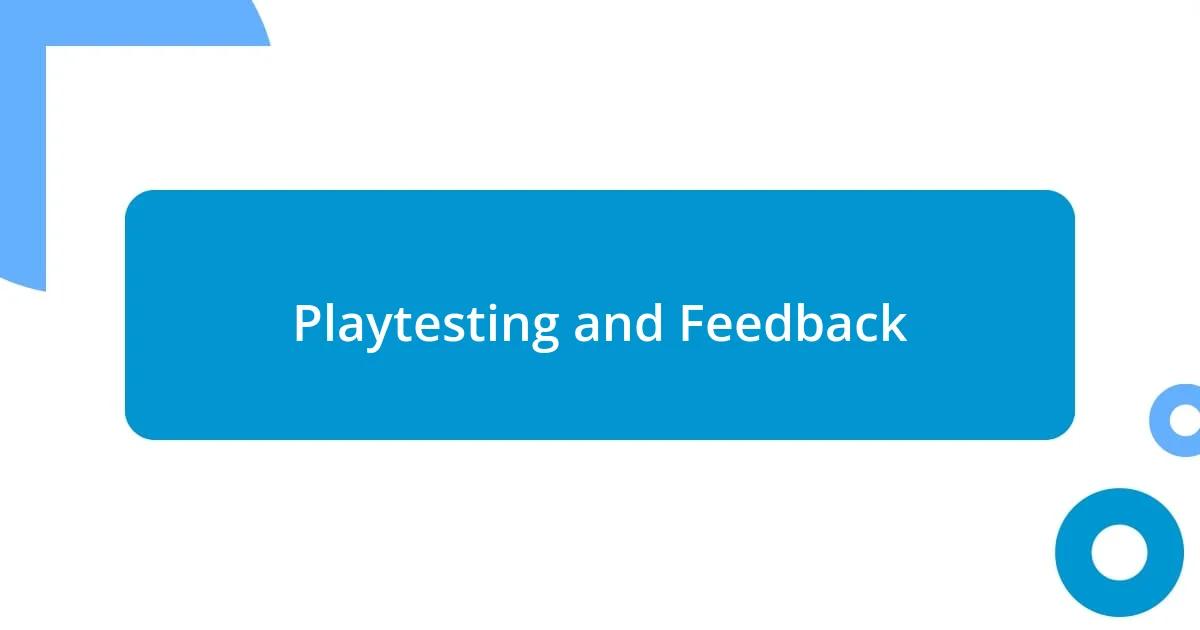
Playtesting and Feedback
Playtesting was a revelatory experience for my level design. I remember gathering a small group of friends to try it out for the first time. Watching them play brought nerves and excitement—would they enjoy my creation as much as I did? Their reactions provided invaluable insight. For example, when one friend got stuck at a particular puzzle, it opened my eyes to the need for clearer hints. It’s incredible how just one player’s struggle can illuminate unseen flaws.
Feedback came in various forms, and I learned to embrace it wholeheartedly. I recall a moment when a player pointed out that the platforming section felt awkwardly paced, leading to frustration. It stung to hear initially, but their perspective was essential. I realized that taking a step back and viewing my design through their eyes was critical. I adjusted the timing and even added an extra checkpoint, which ultimately led to a smoother experience. Isn’t it fascinating how constructive criticism can morph your design into something even better?
The emotional responses during these sessions were just as telling as the gameplay itself. I remember one player nearly shouting in triumph when they conquered a particularly challenging area—it was exhilarating. This reinforced my belief that the highs and lows players experience are what make gameplay memorable. By incorporating their feedback, I aimed not just to create a functioning level, but a thrilling adventure that players would remember long after they finished. Do you see how the player experience and feedback loop are intertwined in shaping something truly special?
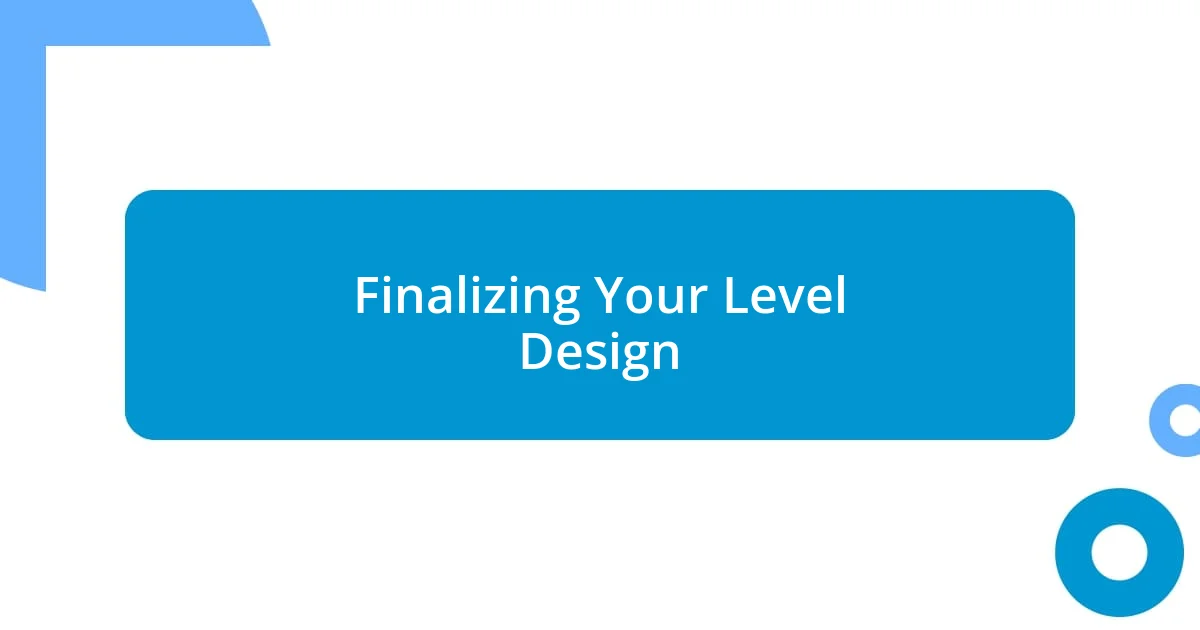
Finalizing Your Level Design
Finalizing my level design required some careful consideration and a dash of bravery. After implementing the feedback from playtests, I felt a strange blend of optimism and anxiety. Would the changes make a significant difference? I don’t think I’ve ever experienced such a mix of excitement and trepidation. Ensuring that every element flowed seamlessly was crucial for creating an engaging gameplay experience.
As I made those final adjustments, I found myself obsessing over the little details. I vividly remember tweaking the lighting in one area to enhance the atmosphere—it was like flipping a switch! The subtle shift turned an ordinary room into a mysterious cavern. I couldn’t help but ask myself, “Isn’t it amazing how something so small can transform the entire mood?” It was in those moments that I understood the power of refinement in level design.
The last phase before finalizing also involved preparing for a second round of playtesting. This time, I was looking for specific reactions. I felt a rush of anticipation, wondering if the adjustments would resonate with my players. Would they notice the enhanced emotions I embedded into the level? I felt deeply connected to my creation, hoping it would not only challenge them but also enchant them. Letting go is tough, but I learned that presenting my level to others was an essential step in truly completing my design journey.












